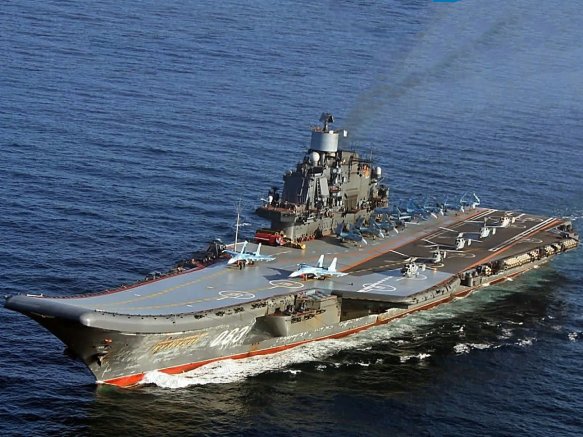Early in the 1970s the Soviet Navy formulated a requirement for a conventional carrier, and a design bureau was assigned to the project in 1973. The initial sketch suggested a nuclear powered vessel of 75,000 to 80,000 tons equipped with four steam catapults and embarking an air group of seventy or more aircraft: fighters, attack aircraft, and aircraft for antisubmarine warfare and airborne early warning. By June 1974 this was revised downward to about 60,000 tons, still with nuclear power, and a fifty-plane air group. Two vessels were included in the 1976 five-year plan but the design parameters again were revised downward by 1979 and finally emerged as the Kuznetsov class, classified as Project 1143.5 although there was little similarity between these ships and the earlier type.
The Kuznetsov class was the first Soviet full decked carrier. Initially they were intended to carry a pair of steam catapults but the designers encountered considerable difficulties in developing a reliable unit, so the carriers were modified to feature a 12-degree ski jump that could launch current jet aircraft using a rolling takeoff into a moderate wind. Otherwise, the design was quite conventional, except that it included a large antiship and antisubmarine missile battery in addition to the usual antiaircraft weapons. The lead ship’s naming history reflects the turmoil inside the Soviet Union during its construction. It was laid down as the Tbilisi, renamed the Leonid Brezhnev on November 18, 1982, and finally, after President Mikhail Gorbachev denounced the former Soviet leader in November 1988, again renamed the Admiral Flota Sovetskogo Soyuza Kuznetsov. The second unit of the class, the Varyag, was incomplete when the Soviet Union broke up and was sold to Chinese investors who propose to convert the ship into a floating casino.
The Soviet Navy’s plans for a very large conventional carrier finally became real with the inclusion of two such nuclear-powered vessels in the 1986 five-year plan. The design was derived from the concepts developed for the 1973 project. The ships were to be 1,089 feet long and 125 feet in beam with a draft of 38 feet and displace 85,000 tons fully loaded. Power came from four nuclear reactors generating steam for four geared turbines producing 200,000 shaft horsepower, sufficient to give them a speed of 30 knots. The flight deck was 246 feet wide across the angled deck and was to carry either two steam catapults in the waist and a 12-degree ski jump forward, or a total of four catapults on a conventional flat flight deck. The air group was seventy to eighty aircraft including antisubmarine helicopters and fixed wing airborne early warning aircraft. Like earlier Soviet carriers, these ships carried powerful antiship and antisubmarine missile batteries in addition to more conventional antiaircraft weapons. The first ship was laid down at the Chernomorskiy Shipyard 444 in Nikolayev on November 25, 1988, as the Kremlin but renamed the Ulyanovsk shortly afterwards. It was 40 percent complete when the Soviet Union broke up. Construction was terminated on November 1, 1991, and the ship was ordered to be scrapped on February 4, 1992, because the Ukraine, where the shipyard was located, and Russia could not agree on how to proceed. A sister ship was due to commence construction on the same slip once the Ulyanovsk was launched.
The Soviet Union’s development of aviation-capable ships followed a logical progression as the navy moved from defending against American ballistic missile submarines to protecting its own strategic submarines and finally projecting its strength against the United States Navy on the open ocean. Since the navy was very much a subordinate service to the army and the strategic rocket forces, it is not surprising that this progression was slow and sometimes tentative, since both political and financial support was limited. Nevertheless, the fleet’s designers demonstrated a clear understanding of the potential of naval aviation in the context of contemporary Soviet strategy and demonstrated themselves capable of producing very effective warships.
Specifications
Designer: Nevskoye Planning and Design Bureau
Builder: Nikolayev South
Displacement: 43 000 standard, 55 000 t full, 58 600 t max load
Length: 300 m (984 ft) overall, 270 m (886 ft) at waterline
Beam: 73 m (240 ft) overall, 38 m (125 ft) waterline
Draft: 11 m (36 ft)
Armament:
12 × P-700 Granit SS-N-19 ‘Shipwreck’ SSM launchers
24 x 3K95 Kinzhal SA-N-9 ‘Gauntlet’ SAM launchers with 8 missiles each
8 x Kashtan air defense modules, each with
2 x 9M311 SA-N-11 ‘Grison’ SAM launchers with 4 missiles each
2 × GSh-6-30 30mm rotary cannon
6 x AK-630 30mm rotary cannon, 6,000 round/min/mount, 24,000 rounds
2 x RBU-12000 UDAV-1 antisubmarine rocket launchers (60 rockets)
Aircraft: (no more than a combination of 67 aircraft can be aboard at one time)
50 Su-33
45 Mig-29
24 Ka-27LD
18 Ka-27PL
6 Ka-27S
Propulsion: Steam turbines, 8 boilers, 4 shafts, 200,000 hp (149 MW)
2 × 50,000 hp (37 MW) turbines
8 boilers
4 fixed pitch props
9 × 1500 kW turbogenerators
6 × 1500 kW diesel generators
Range: 3850 nautical miles (7 100 km) at 32 knot (59 km/h); endurance: 45 days
Speed: 32 knots (59 km/h)
Complement: 1960 + 626 air group + 40 flag, 38579 rooms
